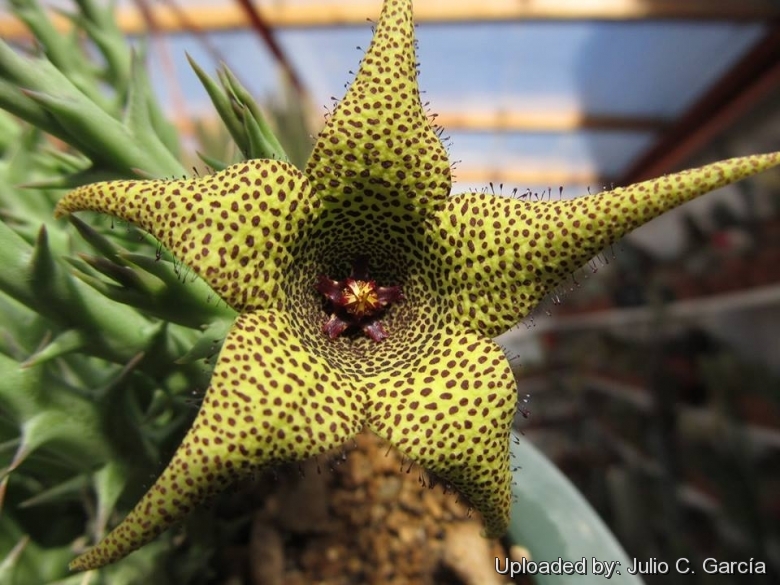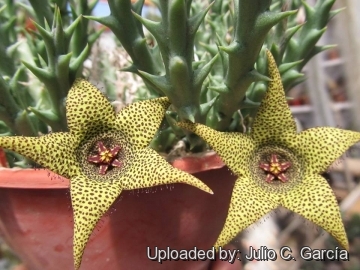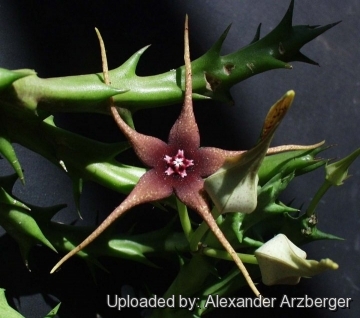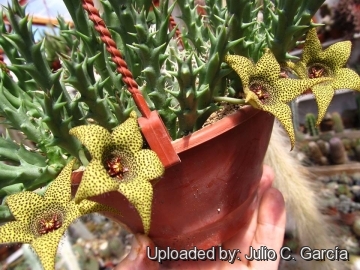Accepted Scientific Name: Caralluma caudata N.E.Br.
Fl. Trop. Afr. [Oliver et al.] 4(1.3): 485. 1903 [Mar 1903]

Orbeopsis caudata (Caralluma caudata) Photo by: Julio C. García
The flowers are yellowish to dark-yellow with reddish or violet spots (rarely completely dark purple).
Origin and Habitat: Malawi, Tanzania, Zambia, Malawi, Mozambique, Zimbabwe, South East Angola, North East Namibia and Botswana.
Type locality: (Nyasaland Namasi)
Habitat: It grows in dry, rocky places dominated by different shrub communities. It grows almost always in half-shaded position under the protection bushes and small trees. This species is from widely separated localities, hence the several varieties.
Synonyms:
See all synonyms of Caralluma caudata
back
Accepted name in llifle Database:Caralluma caudata N.E.Br.Fl. Trop. Afr. [Oliver et al.] 4(1.3): 485. 1903 [Mar 1903]Synonymy: 6
Accepted name in llifle Database:Caralluma caudata subs. rhodesiaca L.C.LeachBothalia 11(1-2): 134 (1973)Synonymy: 8
back
Common Names include:
ENGLISH: Tail bearing Caralluma
Description: Caralluma caudataSN|16423]]SN|16423]] (now transferred to Orbea caudataSN|16424]]SN|16424]] by Bruyns or to Orbeopsis caudataSN|16425]]SN|16425]] by L.C.Leach) has five-pointed fleshy starry flowers produced in late Summer or Autumn. The blooms are delicate and beautiful but exude an intense smell of rotting meat. This perfume attracts blow flies which are the natural pollinators.
Habit: It is a low clumping perennial succulent species that spread over the ground forming lax cushions. Plant to 9 cm tall and up to 20 cm in diameter.
Stems: 8-10 cm long 7-10 mm across, excluding teeth. Teeth long-tapering, spine-like, more or less spaced, horizontally spreading or up-curved 9-10 mm long and 5-8 mm broad at the base. Epidermis brownish-green or dark olive-green or grey-green more or less mottled with brownish or purple.
Flowers: Usually solitary or few together in pseudo-umbels near base of stem, rarely more than 2 open at once. Flowering stalks, erect, 5-20 mm long 2-3 mm large. Flowers buds up to 3,8 cm long 5-angled terminating in a slight spiral. Bracts 2,5 mm stiff. Corolla 4-9 cm in diameter, very deep-cleft, basin-shaped at the base, lobes up to 22 mm long, outside whitish stippled with red, inside not wrinkled variably downy or papillose, yellowish to dark-yellow with reddish or violet spots (rarely completely dark purple). Lobes lanceolate-acuminate to caudate, 22-40 cm long, 6-9 mm wide, horizontally spreading, border ciliate below, recurred above. Hairs purple to violet vibratile. Corona yellowish-red 4-7 mm in diameter, often entirely within the central purple depression. Outer corona-lobes 1,5 mm long, inner corona-lobes simple, lying over anthers, without extended horn. Pollinia 0,5 mm long 0,35 mm wide, bean- or D-shaped
Blooming season: This species produces few flowers simultaneously in late summer to autumn. Following successful pollination of flowers pairs of seed horns are produced, packed with seeds attached to silky parachutes.
Subspecies, varieties, forms and cultivars of plants belonging to the Caralluma caudata group
 Caralluma caudata N.E.Br.: (subsp. caudata) Stems olive-green with purplish flecks, tubercles 5-10 mm long. Distribution: Malawi, Tanzania, Zambia, Malawi, Mozambique, Zimbabwe, South East Angola, North East Namibia and Botswana.
Caralluma caudata N.E.Br.: (subsp. caudata) Stems olive-green with purplish flecks, tubercles 5-10 mm long. Distribution: Malawi, Tanzania, Zambia, Malawi, Mozambique, Zimbabwe, South East Angola, North East Namibia and Botswana. Caralluma caudata subs. rhodesiaca L.C.Leach: Stems grey-green with purplish flecks, tubercles 12-25 mm long. Distribution: Angola, Namibia, Zimbabwe and Botswana.
Caralluma caudata subs. rhodesiaca L.C.Leach: Stems grey-green with purplish flecks, tubercles 12-25 mm long. Distribution: Angola, Namibia, Zimbabwe and Botswana.
Bibliography: Major references and further lectures
1) White & Sloane. “The Stapdleae” edn 2. Abbey San Encino Press, 1937
2) James Cullen, Sabina G. Knees, H. Suzanne Cubey “The European Garden Flora Flowering Plants: A Manual for the Identification of Plants Cultivated in Europe, Both Out-of-Doors and Under Glass” Cambridge University Press, 11/Aug/2011
3) Carl August Lückhoff “The stapelieae of Southern Africa” A. A. Balkema, 1952
4) Doreen Court “Succulent Flora of Southern Africa” A.A. Balkema, 2000
5) Hermann Jacobsen “A handbook of succulent plants: descriptions, synonyms, and cultural details for succulents other than Cactaceae, Volume 1” Blandford Press, 1960
6) P. V. Bruyns “Monograph of Orbea and Ballyanthus: (Apocynaceae- Asclepiadoideae- Ceropegieae") American Society of Plant Taxonomists, 2002
7) Alison Heath, Roger Heath “Field guide to the plants of northern Botswana, including the Okavango Delta: useful in countries and geographical areas adjacent to northern Botswana in the Zambesi Basin” Royal Botanic Gardens, Kew, 15/Jun/2010
8) Bruyns, P.V. "Monograph of Orbea and Ballyanthus (Apocynaceae-Asclepiadoideae-Ceropegieae)" Systematic Botany Monographs 63 Pages 102 - 106. 2002
9) Bruyns, P.V. "Stapeliads of Southern Africa and Madagascar" Volume I Umdaus Press, Hatfield, South Africa Pages 257 - 259. 2005
10) Golding, J.S. (ed.) "Southern African Plant Red Data Lists." Southern African Botanical Diversity Network Report No. 14. SABONET. Pretoria. Page 162. 2002
11) Leach, L.C. "A contribution towards a new classification of Stapelieae (Asclepiadaceae) with a preliminary review of Orbea Haw. and descriptions of three new genera" Excelsa Taxonomic Series No. 1 Aloe, Cactus and Succulent Society of Zimbabwe Page 68. as Orbeopsis caudata subsp. rhodesiaca 1978
12) Mapaura, A & Timberlake, J. (eds) "A checklist of Zimbabwean vascular plants" Southern African Botanical Diversity Network Report No. 33 Sabonet, Pretoria and Harare Page 21. 2004
 Orbeopsis caudata (Caralluma caudata) Photo by: Julio C. García
Orbeopsis caudata (Caralluma caudata) Photo by: Julio C. García Orbeopsis caudata (Caralluma caudata) Photo by: Alexander Arzberger
Orbeopsis caudata (Caralluma caudata) Photo by: Alexander Arzberger Orbeopsis caudata (Caralluma caudata) Photo by: Valentino Vallicelli
Orbeopsis caudata (Caralluma caudata) Photo by: Valentino Vallicelli Orbeopsis caudata (Caralluma caudata) Photo by: Julio C. García
Orbeopsis caudata (Caralluma caudata) Photo by: Julio C. García Orbeopsis caudata (Caralluma caudata) Photo by: Valentino Vallicelli
Orbeopsis caudata (Caralluma caudata) Photo by: Valentino VallicelliSend a photo of this plant.The gallery now contains thousands of pictures, however it is possible to do even more. We are, of course, seeking photos of species not yet shown in the gallery but not only that, we are also looking for better pictures than those already present.
Read More... Cultivation and Propagation: Caralluma caudataSN|16423]]SN|16423]] is a xerophytic plant adapted to dry soils, but despite its provenance it is without doubt an easy species to grow and not difficult as commonly supposed only bearing in mind that this species benefits from slightly warmer winter than others.
Growth rate: It is a relatively rapidly growing and easily flowering species that will make large clumps given the best conditions. Most plants will offset readily, and clumps can be produced in a few years.
Soils: It likes very porous mineral cactus mix soil, pH 7,5 to 8,5 (mildly alkaline), but can become too elongated if compost is too rich.
Repotting: This plant needs plenty of space for its roots, repotting should be done every other year or when the it has outgrown its pot. Use pot with good drainage.
Watering: It needs regular watering, especially during the hottest summer days; provide also some light watering if the green house temperatures in winter are elevated. Either excessive or very scarce watering can induce rot.
Fertilization: Feed with a high potassium fertilizer in summer.
Frost Tolerance: For safe cultivation it is best to avoid freezing temperatures (minimum 5° C). In the rest period no high atmospheric humidity!!
Sun Exposure: Best for half-shade but grow well in full sun and full shade too. Tends to bronze in strong light, which encourages flowering, but is likely to suffer from sun scorch or stunted growth if over exposed to direct sunlight during the hottest part of the day in summer.
Diseases: This species is relatively resistant to cryptogamic diseases than others and is quite resistant to the “Balck spot” disease of Asclepiads. Rot it is only a minor problem with Caralluma caudataSN|16423]]SN|16423]] if the plants are watered and “aired” correctly. If they are not, fungicides won't help all that much.
Uses: It is an excellent plant for container growing. Cascading, clustering, great for a hanging display. Stems may possibly become purple and limp in winter, but revitalize in early spring. It always looks good and stays small. It look fine in a cold greenhouse and frame or outdoor in a rockery.
Propagation: Seeds and cuttings. Cuttings will root only in hot weather. Cuttings must be kept very dry to root. Seeds germinate readily if they are sown when fresh.















